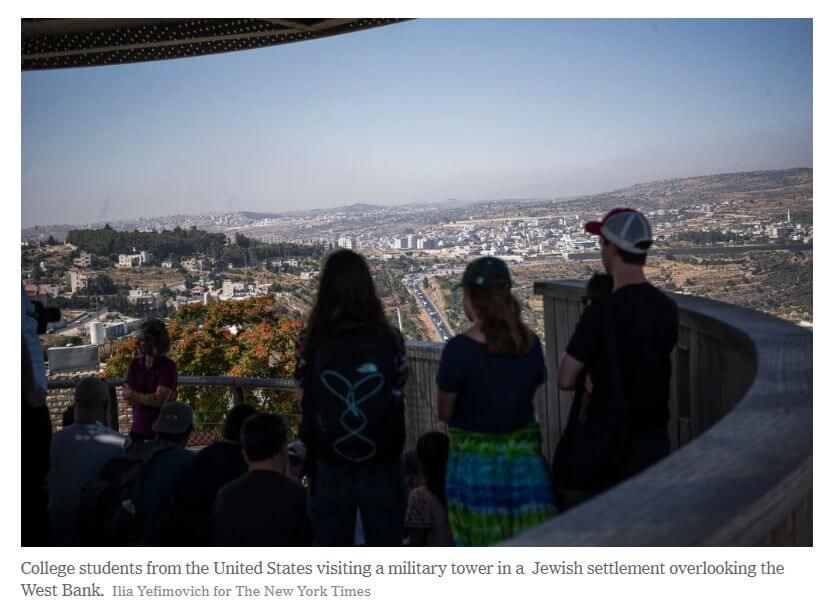The recent US presidential order targeting antisemitism on campus has unleashed an enormous amount of debate both in the media and within the US Jewish community. The discussion has been multifaceted, touching on issues including: Jewish identity, partisan US politics, freedom of speech, defining antisemitism and where legitimate criticism of Israel begins and ends.
At HonestReporting, we endorse the International Holocaust Remembrance Alliance working definition of antisemitism. We also support efforts to protect Jewish students from antisemitism on campus as defined by the IHRA definition. We do not support efforts to shut down legitimate discussion and debate surrounding Israel and we make it crystal clear that neither does the IHRA definition.
Issues surrounding how American Jews self-define is beyond the scope of HonestReporting’s remit. However, we will point out the bias inherent in a New York Times piece examining national identity and the roots of Jewish nationhood against the context of the Trump executive order.
Join the fight for Israel’s fair coverage in the news
Misrepresentation
Columnist Max Fisher writes:
Mr. Trump’s order, for purposes of monitoring educational institutions’ handling of discrimination, places Jews under Civil Rights Act protections based on race, color or national origin. The order also draws on a 2005 definition of anti-Semitism, one of whose authors has since said is overly broad, conflating hatred of Jews with criticism of Israel.
Fisher refers to an opinion piece by Kenneth Stern in The Guardian where, despite his role in drafting the original working definition of antisemitism that IHRA is based on, he opposes the Trump executive order. His argument however, is not that the definition is “overly broad, conflating hatred of Jews with criticism of Israel,” as Fisher claims.
Fisher has either misread Stern’s piece or deliberately distorted it to fit his own politics. Stern pointedly does not take issue with the definition itself but with how it is used. He argues that the definition was meant to be a means to monitor and collect data on antisemitism rather than a legal tool to be actively deployed to fight antisemitism. Stern doesn’t claim in his article that the IHRA definition could conflate hatred of Jews with criticism of Israel. It is Jewish organizations that he accuses of doing so. Indeed the definition itself that he had a hand in drafting clearly states that “criticism of Israel similar to that leveled against any other country cannot be regarded as antisemitic.”
Fisher’s interpretation is simply wrong.
Palestinians or Israeli-Arabs?
Fisher also writes:
In a twist of history, the creation of Israel put Jews on the opposite side of the question: Now they had to decide whether a Jewish national identity had room for minorities.
Early Zionist leaders insisted that it did. But more recent Israeli leaders have promoted Israeli identity as exclusively Jewish and have imposed severe restrictions on Palestinians.
Is Fisher confused? Palestinians living under the control of the Palestinian Authority in the West Bank or Hamas in Gaza are irrelevant to a discussion on Israeli identity. They are not Israeli citizens and clearly have no desire to identify as such.
So is Fisher really referring to the Israeli-Arab minority that does have Israeli citizenship? Undoubtedly there has been some ugly political discourse in recent times as some Israeli politicians have appealed to nationalist sentiments. This has not, however, entailed the imposition of “severe restrictions” on the rights of Israeli Arabs, whose Joint List is the third largest political party in the current Knesset.
Photo bias
The choice of photos in the piece is the responsibility of the New York Times. So why are these photos relevant to the op-ed?


Why is a photo of the Palestinian part of Hebron relevant to the discussion? The column is about Jewish identity not about the Arab-Israeli conflict.
Interestingly, the caption refers to “the city of Hebron in Israel.” Given the New York Times’ attitude towards Israel’s control over the disputed territories, this comes as something of a surprise.
Why are US college students visiting a military tower in a Jewish settlement relevant to the discussion? After all, there’s nothing in the IHRA definition of antisemitism that freezes the legitimate debate over settlements or other aspects of Israeli government policy.
But then, the New York Times has a problem acknowledging that the antisemitism that Jewish students are suffering on campus is not about Israeli policy but about Israel’s very existence as a Jewish state – something that the leadership of the boycott, divestment and sanctions movement, has openly acknowledged.
HonestReporting has registered a complaint with the New York Times.
Please add you complaint by sending an email to [email protected].


